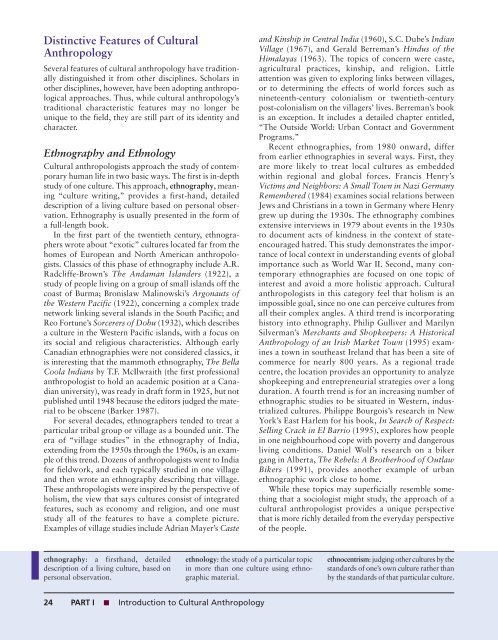PART Introduction to Cultural Anthropology - Pearson Canada
PART Introduction to Cultural Anthropology - Pearson Canada
PART Introduction to Cultural Anthropology - Pearson Canada
Create successful ePaper yourself
Turn your PDF publications into a flip-book with our unique Google optimized e-Paper software.
Distinctive Features of <strong>Cultural</strong><br />
<strong>Anthropology</strong><br />
Several features of cultural anthropology have traditionally<br />
distinguished it from other disciplines. Scholars in<br />
other disciplines, however, have been adopting anthropological<br />
approaches. Thus, while cultural anthropology’s<br />
traditional characteristic features may no longer be<br />
unique <strong>to</strong> the field, they are still part of its identity and<br />
character.<br />
Ethnography and Ethnology<br />
<strong>Cultural</strong> anthropologists approach the study of contemporary<br />
human life in two basic ways. The first is in-depth<br />
study of one culture. This approach, ethnography, meaning<br />
“culture writing,” provides a first-hand, detailed<br />
description of a living culture based on personal observation.<br />
Ethnography is usually presented in the form of<br />
a full-length book.<br />
In the first part of the twentieth century, ethnographers<br />
wrote about “exotic” cultures located far from the<br />
homes of European and North American anthropologists.<br />
Classics of this phase of ethnography include A.R.<br />
Radcliffe-Brown’s The Andaman Islanders (1922), a<br />
study of people living on a group of small islands off the<br />
coast of Burma; Bronislaw Malinowski’s Argonauts of<br />
the Western Pacific (1922), concerning a complex trade<br />
network linking several islands in the South Pacific; and<br />
Reo Fortune’s Sorcerers of Dobu (1932), which describes<br />
a culture in the Western Pacific islands, with a focus on<br />
its social and religious characteristics. Although early<br />
Canadian ethnographies were not considered classics, it<br />
is interesting that the mammoth ethnography, The Bella<br />
Coola Indians by T.F. McIlwraith (the first professional<br />
anthropologist <strong>to</strong> hold an academic position at a Canadian<br />
university), was ready in draft form in 1925, but not<br />
published until 1948 because the edi<strong>to</strong>rs judged the material<br />
<strong>to</strong> be obscene (Barker 1987).<br />
For several decades, ethnographers tended <strong>to</strong> treat a<br />
particular tribal group or village as a bounded unit. The<br />
era of “village studies” in the ethnography of India,<br />
extending from the 1950s through the 1960s, is an example<br />
of this trend. Dozens of anthropologists went <strong>to</strong> India<br />
for fieldwork, and each typically studied in one village<br />
and then wrote an ethnography describing that village.<br />
These anthropologists were inspired by the perspective of<br />
holism, the view that says cultures consist of integrated<br />
features, such as economy and religion, and one must<br />
study all of the features <strong>to</strong> have a complete picture.<br />
Examples of village studies include Adrian Mayer’s Caste<br />
and Kinship in Central India (1960), S.C. Dube’s Indian<br />
Village (1967), and Gerald Berreman’s Hindus of the<br />
Himalayas (1963). The <strong>to</strong>pics of concern were caste,<br />
agricultural practices, kinship, and religion. Little<br />
attention was given <strong>to</strong> exploring links between villages,<br />
or <strong>to</strong> determining the effects of world forces such as<br />
nineteenth-century colonialism or twentieth-century<br />
post-colonialism on the villagers’ lives. Berreman’s book<br />
is an exception. It includes a detailed chapter entitled,<br />
“The Outside World: Urban Contact and Government<br />
Programs.”<br />
Recent ethnographies, from 1980 onward, differ<br />
from earlier ethnographies in several ways. First, they<br />
are more likely <strong>to</strong> treat local cultures as embedded<br />
within regional and global forces. Francis Henry’s<br />
Victims and Neighbors: A Small Town in Nazi Germany<br />
Remembered (1984) examines social relations between<br />
Jews and Christians in a <strong>to</strong>wn in Germany where Henry<br />
grew up during the 1930s. The ethnography combines<br />
extensive interviews in 1979 about events in the 1930s<br />
<strong>to</strong> document acts of kindness in the context of stateencouraged<br />
hatred. This study demonstrates the importance<br />
of local context in understanding events of global<br />
importance such as World War II. Second, many contemporary<br />
ethnographies are focused on one <strong>to</strong>pic of<br />
interest and avoid a more holistic approach. <strong>Cultural</strong><br />
anthropologists in this category feel that holism is an<br />
impossible goal, since no one can perceive cultures from<br />
all their complex angles. A third trend is incorporating<br />
his<strong>to</strong>ry in<strong>to</strong> ethnography. Philip Gulliver and Marilyn<br />
Silverman’s Merchants and Shopkeepers: A His<strong>to</strong>rical<br />
<strong>Anthropology</strong> of an Irish Market Town (1995) examines<br />
a <strong>to</strong>wn in southeast Ireland that has been a site of<br />
commerce for nearly 800 years. As a regional trade<br />
centre, the location provides an opportunity <strong>to</strong> analyze<br />
shopkeeping and entrepreneurial strategies over a long<br />
duration. A fourth trend is for an increasing number of<br />
ethnographic studies <strong>to</strong> be situated in Western, industrialized<br />
cultures. Philippe Bourgois’s research in New<br />
York’s East Harlem for his book, In Search of Respect:<br />
Selling Crack in El Barrio (1995), explores how people<br />
in one neighbourhood cope with poverty and dangerous<br />
living conditions. Daniel Wolf’s research on a biker<br />
gang in Alberta, The Rebels: A Brotherhood of Outlaw<br />
Bikers (1991), provides another example of urban<br />
ethnographic work close <strong>to</strong> home.<br />
While these <strong>to</strong>pics may superficially resemble something<br />
that a sociologist might study, the approach of a<br />
cultural anthropologist provides a unique perspective<br />
that is more richly detailed from the everyday perspective<br />
of the people.<br />
ethnography: a firsthand, detailed<br />
description of a living culture, based on<br />
personal observation.<br />
ethnology: the study of a particular <strong>to</strong>pic<br />
in more than one culture using ethnographic<br />
material.<br />
ethnocentrism: judging other cultures by the<br />
standards of one’s own culture rather than<br />
by the standards of that particular culture.<br />
24 <strong>PART</strong> I ■ <strong>Introduction</strong> <strong>to</strong> <strong>Cultural</strong> <strong>Anthropology</strong>
















